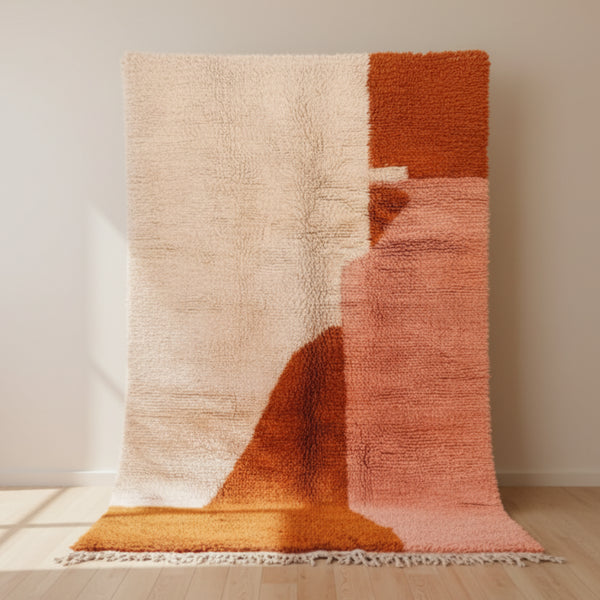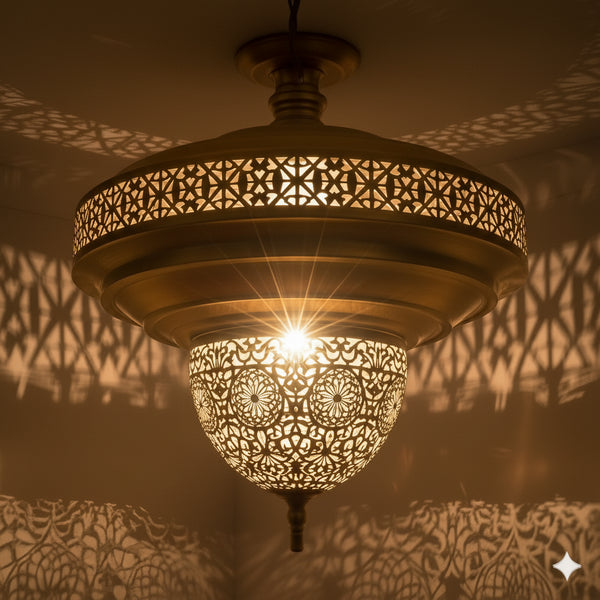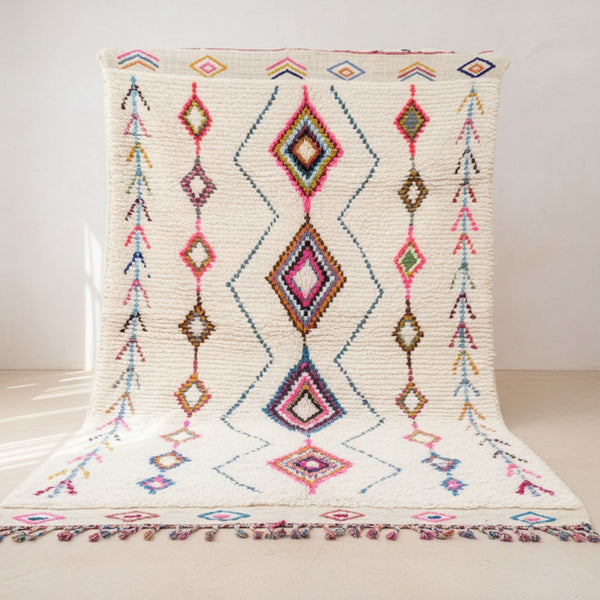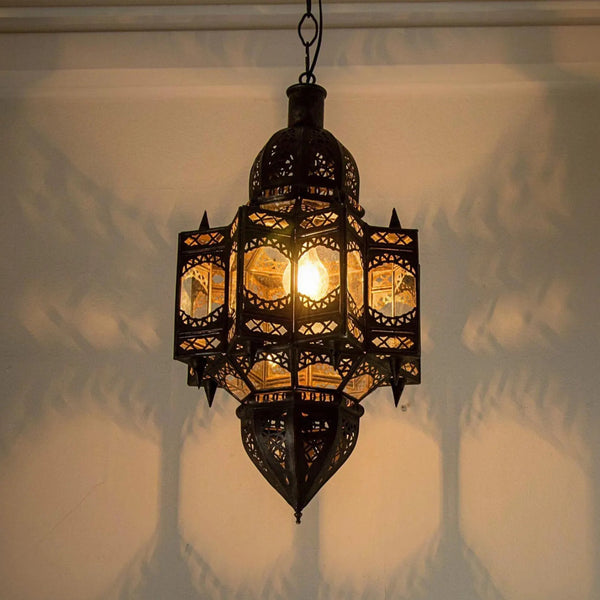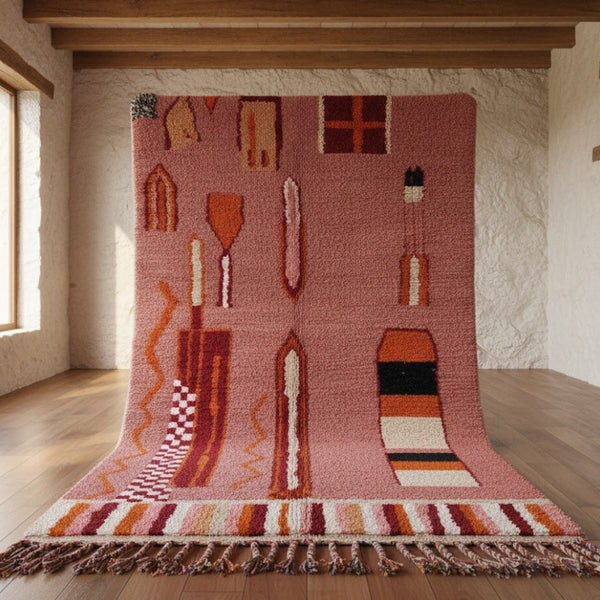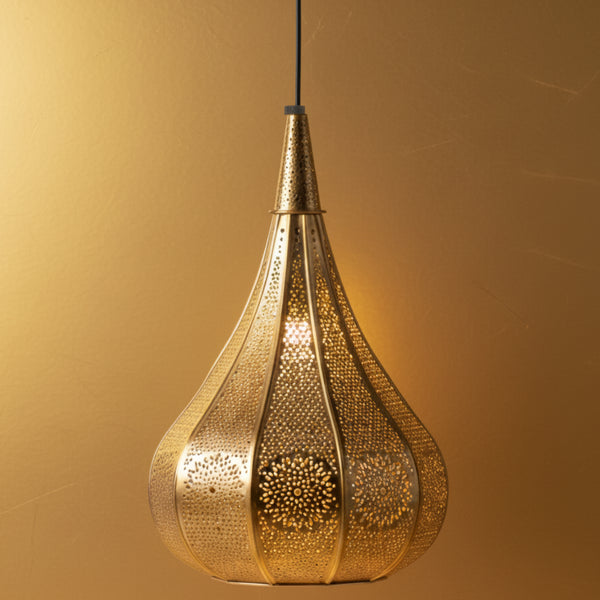Caring for a Handmade Moroccan Wool Rug in High-Traffic Areas
Posted by AADIL KHAN
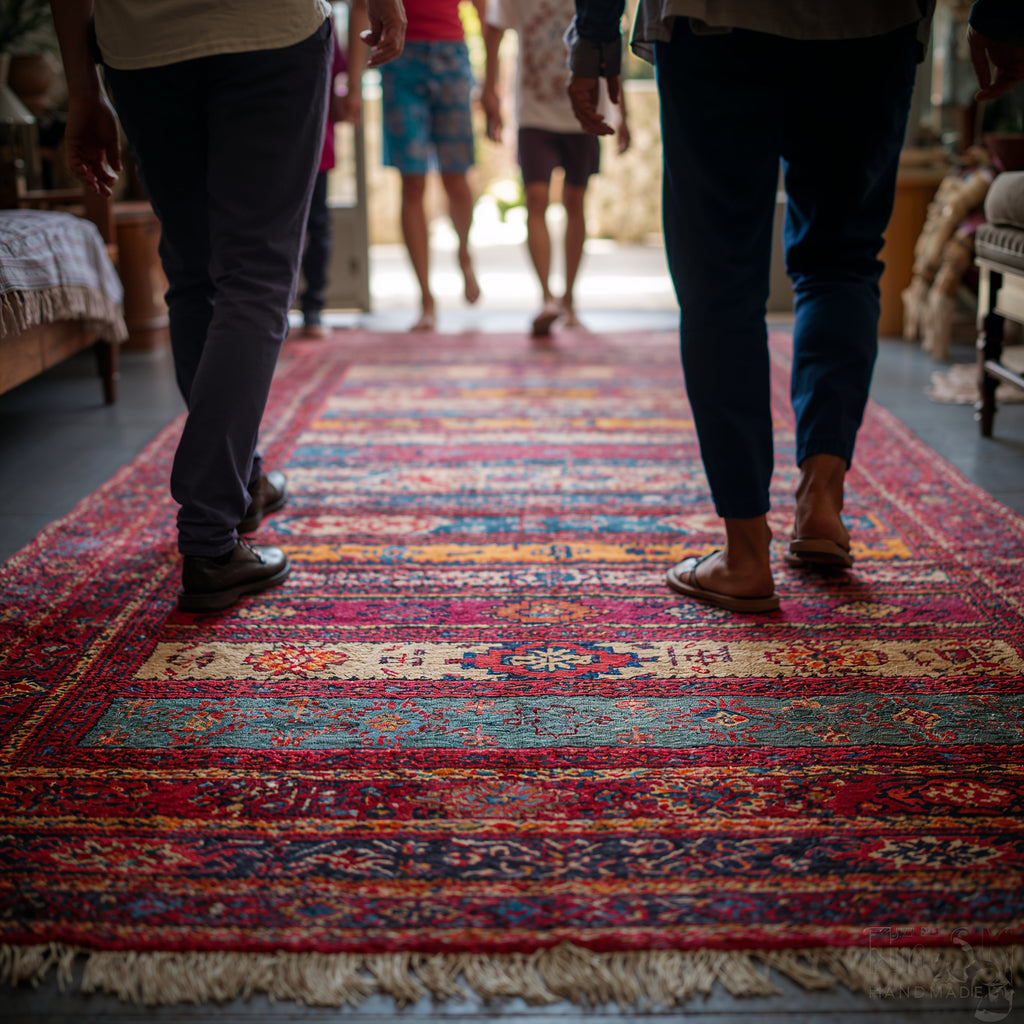
Handmade Moroccan wool rugs do more than cover the floor; each one is a small, living archive of the artisans culture and stories. With their bold motifs and soft, inviting pile, they can instantly warm a room, ground eclectic decor, and whisper of distant markets. Still, if you place such a treasure in a busy hallway, foyer, or family lounge, the constant stomping and the occasional spill raise an obvious question: how do you keep it spotless and fresh? High-traffic spots endure odours, grit, and fading far faster than quieter corners, so protecting your valuable rug there can feel intimidating.
This easy-to-follow guide gives you clear, step-by-step advice for caring for a handmade Moroccan wool rug even in the busiest zones of your house. Well cover light daily upkeep, seasonal deep-cleans, quick spot fixes, and even stylish tricks like layering smaller pieces to distribute weight. Our intent is to keep the colours sharp, the fibers strong, and every knotted story intact, so your rug remains the beloved focal point it is now. From mundane chores you can handle in five minutes to signs that a rug doctor is really required, we will lead you through each stage of protecting your exquisite rug for years to come.
Why It's Worth the Effort to Own a Handmade Moroccan Wool Rug
Owning a handmade Moroccan wool rug quickly proves itself to be an absorbing experience. These pieces are not churned out by factories; each carpet carries a narrative woven by artisans who hand down technique after technique through generations. The high-grade wool still holds natural lanolin, so dirt and stains slide off instead of settling in, granting surprising resilience while the rug retains its gentle look. Its distinctive motifs and vivid dyes echo Moroccos deep cultural history and give any room a warmth and authenticity that machine-made goods simply cannot provide.
Though the upfront cost of a handcrafted Moroccan wool rug exceeds that of mass-produced synthetic options, its enduring life and classic charm soon prove the purchase sensible. When cared for properly, such a rug can endure for decades, eventually transforming into a beloved family keepsake. Its strength, paired with rich color and obvious handmade skill, clearly distinguishes the piece and makes the routine upkeep worthwhile. The time you invest in cleaning and protecting the rug pays back in lasting beauty and value, allowing the piece to enrich your home across generations. To view our curated selection, please browse the Handmade Moroccan Wool Rugs collection on our website.
Daily Maintenance Tips to Keep Your Handmade Moroccan Wool Rug Looking Fresh
Routine daily and weekly attention is your best defense against wear in busy areas and is essential for maintaining the rug's color and texture. By whisking away crumbs and loose dust, you stop these particles from settling deep in the fibers, where they would dull the wool's luster and accelerate fading.
First and foremost, vacuuming often is the simplest way to care for your rug. For a handmade Moroccan wool piece, use a vacuum that lets you turn off the brush roll or set it to the high-pile mode. The full beater-bar setting is usually too aggressive for wool and may loosen fibers or create extra shedding. Instead, stick with the suction-only nozzle or adjust the height to match the rug. Always vacuum in the pile direction to minimize tugging, and hit the rug once or twice a week-more often in heavy foot-traffic zones. Regular passes lift loose dirt, dust, and pet hair before they settle deep.
For smaller rugs, take them out on the porch or yard and give a good, gentle shake. The move releases an impressive amount of trapped grit without bringing a vacuum outdoors. Remember to stand far enough from open doors and windows so the dust does not blow back inside.
Rotate your rug every few months. Uneven wear is common in high-traffic areas. Turning your handmade Moroccan wool rug 180 degrees every three to six months exposes different sections to footsteps and sunlight, so fading and matting develop evenly across the surface. This small habit can greatly lengthen both the life and the visual appeal of the rug.
Deep-Cleaning Advice for High-Traffic Zones

Daily vacuuming keeps the surface of your handmade Moroccan wool rug tidy, yet the busiest patches will eventually need a deeper clean to lift trapped grit and refresh the fibers. When that time comes, work softly and steer clear of harsh chemicals that might strip the wool's natural lanolin or bleed its dyes.
Begin with a thorough dry-cleaning approach. Before any liquid touches your handmade Moroccan wool rug, give it a deep, dry clean. Evenly sprinkle a generous layer of baking soda across the whole surface. This kitchen staple acts as a natural deodorizer and soaks up oils and dust. Leave the soda in place for several hours-or overnight-so it can work into the fibers. Then vacuum the rug slowly, removing every trace of powder. Completing this step often cuts the amount of damp cleaning needed and is especially good at lifting smells.
For spots that still look dirty, you may use a mild shampoo safe for wool, but always test it first on a hidden edge. Follow the makers directions to dilute the cleaner. With a soft brush or sponge, gently work the suds into the pile section by section. Take care not to soak the rug; too much water invites mildew and can weaken the backing of these handmade pieces. When scrubbing is done, press clean, dry towels on the area until they pull up as much moisture as possible.
Rinse thoroughly, but do so with care. If you clean using the wet method, wash away every trace of soap. You can achieve this by blotting the surface with clean cloths moistened in plain water. Again, keep each cloth damp-not dripping-to avoid overwetting.
Drying the rug completely is vital. After any wet cleaning, lay the handmade Moroccan wool rug flat in a breezy area out of direct sun. If you can, place fans nearby or run a dehumidifier to draw moisture from the air and fibers. Never return a damp rug to the floor or stash it in a humid space, because that invites mildew, odor, and weak spots. A thick, handwoven wool rug may take several days to dry fully. When it is dry, gently lift the pile with your fingers or a soft brush to revive its even texture.
Spot Cleaning Techniques That Preserve the Integrity of Handcrafted Rugs
Accidents occur, especially in busy rooms. Fast, correct spot cleaning keeps spills from sinking deep into a handcrafted rug. The secret is to respond quickly and use milder tools and solutions that respect the fibers and knots.
Blot, dont rub. That single idea should guide anyone wiping a drink or crumb off a handmade carpet. Abrasive rubbing can widen the mark, shove it deeper into the yarn, and even crush the pile. Instead, grab a clean white cloth or a plain paper towel and gently press outward from the stain's center. Keep repeating until the cloth stops picking up color or texture.
For liquid spills: tackle water, soda, or juice with a dry cloth first. If the liquid is tinted, mix a scant drop of dish soap in warm water. Lightly dampen a new cloth with that blend and dab the stain. Finish by dabbing again with plain water to rinse away soap so fibers dont attract fresh dirt.
For solid or semi-solid spills: mud, ice cream, or a melted candy should air-dry first if time allows. Once the mess has set, ease off as much as you can with the dull edge of a knife or spoon. Return to the blotting technique for any leftover residue, adding soap mix as needed.
Grease stains: when oil settles in, sprinkle cornstarch or baking soda liberally over the mark. The powder absorbs the grease as it sits, so leave it alone for fifteen to thirty minutes. Afterwards, gently vacuum or brush the residue away and, if the stain lingers, repeat the process. Once the bulk of the oil is gone, dab the spot with a cloth moistened in mild dish soap mixed with water, then rinse with clean water.
Pet accidents: respond without delay. Blot up as much urine as you can using folded, absorbent towels. Next, mix equal parts white vinegar and water and gently blot it over the damp area to neutralize odor and disinfect. Follow that with plain water, again blotting to rinse. For lingering smells, try an enzymatic cleaner formulated for pet stains, but test it first on a hidden spot of your rug. Always verify the product is safe for wool.
Whatever method you choose, let the treated area dry completely before walking on it. Placing a fan nearby or opening windows speeds drying and helps prevent residual odor.
Layering Ideas: Protecting Your Rug with Bohemian Rugs and Accessories

Layering rugs is a quick, stylish way to add depth and texture to a room, and it also acts as a simple shield for your treasured handmade Moroccan wool rug in busy spots. When properly arranged, the top pieces flaunt their beauty while the layers beneath absorb most scuffs and spills. To make the look relaxed and personal, think about mixing in a few bohemian styles or other rugs that echo the colors and patterns you already own.
A common method is to start with a larger, tough rug on the floor and to place the Moroccan piece directly on top. An everyday natural-fiber choice-jute, sisal, or a low-pile flatweave-makes an ideal working base. These grasses and weaves handle heavy foot traffic and brush clean with relative ease. When the handmade rug rests atop this hardy underlayer, it gains a cushion that soaks up the worst of that traffic, accidental drips, and the daily grind.
Think about laying a few small, purposely chosen bohemian rugs atop your main Moroccan piece in high-wear spots, like right in front of the sofa or at the door. Because these little rugs are light, you can quickly clean, flip, or swap them out before they get threadbare, while the bigger, pricier rug stays shielded below. Choose bohemian styles with tight weaves, eye-catching motifs, or plush texture that harmonize with the Moroccan look instead of fighting it. Our curated range of bohemian rug features plenty of options that pair nicely with classic Moroccan designs.
Protective accessories can help, too. Sliding coasters or felt pads under furniture legs stops dents and shiny patches on the handmade wool surface. At entrances, a solid exterior doormat plus a machine-washable runner inside traps dirt and moisture before either reaches the main rug. Taken together, these simple extras can greatly prolong both the function and the beauty of your Moroccan rug.
Seasonal Rotation and Placement Strategies for Handmade Moroccan Wool Rugs
Smart placement combined with routine rotation protects your handmade Moroccan wool rug from the rigors of busy hallways or living rooms. Spreading wear across the entire piece keeps specific areas from fading, fraying, or losing texture faster than the rest.
As already noted in daily care, turn the rug 180 degrees every three to six months. In a bustling living room, the strip closest to the main walkway will inevitably take the hardest hit. Rotating the rug moves that hotspot elsewhere, letting every section share the burden. The same principle holds for sunlight. Although natural light showcases the rugs vivid dyes, leaving one corner in direct sun day after day will cause patchy fading. Rotation even out that fading, too.
Strategic Placement: When you first lay your handmade Moroccan wool rug, pause to note how people will move through the space. In an entry hall, for example, a long runner that follows the full route is smarter than a tiny mat that catches only a corner. In the living room, arrange sofas and chairs so the busiest routes brush over the edges of the rug, or drop a sturdier piece underneath and layer the Moroccan rug on top.
Furniture Placement: Watch how furniture lands on the rug once it is in place. The weight of sofa legs can dimple the pile, trap air, and, in humid rooms, invite damp patches or mildew. Slide felt pads or plastic cups under heavy seats to spread weight and make moving them for cleaning easier. Now and then move the pieces a few inches in another direction to stop permanent marks and give every section of the rug a turn to breathe.
Think about moving your handmade Moroccan wool rugs from room to room whenever you can. For example, shift a rug from a busy living room to a quieter guest bedroom, then repeat the move in a few months. Giving the rug this short break in high traffic lets the fibers rest and can notably stretch its life. Regular rotation, paired with thoughtful placement, stands as one of the simplest yet most effective ways to care for these artisanal pieces.
When to Seek Professional Cleaning for Your Handcrafted Rug
Daily spot cleaning and gentle vacuuming do much for your handcrafted rug, yet some stains or built-up grit will refuse to budge. At that point, calling in a professional becomes not just helpful but necessary to protect the fibers, color, and backing from permanent damage. Knowing when to hand the care work over to an expert can safeguard your investment and keep your beautiful rug looking its best for many years.
General Soiling: Even with regular vacuuming and quick spot treatment, your handcrafted rug will still trap dust, allergens, and hidden dirt that the household machine fails to reach. If the colors seem dull, the pile feels gritty, or the surface has lost its sheen despite your care, those clues suggest it needs a thorough professional scrub. In busy hallways or living rooms, this level of cleaning may be needed every twelve to eighteen months, moving closer to once a year when foot traffic, pets, or children add to the grind.
Stubborn Stains and Odors: When marks refuse to lift or when a pet spill-or any spill, really-was not dried properly and has left behind an unwelcome smell, industry-grade tools and formulas offer the safest way forward. Expert cleaners first identify the rug's material and the source of the stain so that they can apply the gentlest, most effective method, preserving the colors and structure you love.
Post-Flood or Water Damage: If your handmade rugs have been soaked by a leak, flood, or days of damp air, call in a rug specialist at once. Trained cleaners know how to pull out hidden moisture, stop mold and mildew before they start, and protect both the backing and the fibers from permanent harm. Trying to air-dry a heavily saturated rug on your own can set the stage for cracking, discoloration, or loss of structure that cannot be fixed.
Restoration and Repair: Cleaning is only the first step; many rug shops also handle repair and restoration for fine pieces. When a rug shows worn or torn fringes, loose edges, or tiny holes, an expert can reweave, rebind, or patch so the damage does not spread and the rugs value stays intact.
When you pick a cleaner, choose one who focuses on handmade pieces and knows wool inside and out. Ask about the process they follow and confirm they use pH-neutral, wool-safe soaps, gentle drying methods, and low-heat tools. A trustworthy shop will also explain routine care and proper storage to keep your rug healthy between cleanings. By putting your handmade rugs in the hands of true professionals, you give them the expert attention they require. To learn more about the artistry behind our collection, please visit our Artisan Rugs page.
Keeping a handmade Moroccan wool rug looking good in busy rooms may feel daunting at first, yet, armed with a few simple tips and steady attention, it soon proves quite doable. Regular gentle vacuuming, quick blotting of spills, planned turning to level fading, and even layering smarter mats all work together to guard the rugs colors and knots against daily wear. Above all, thoughtful care safeguards your budget and pays respect to the remarkable skill and history woven into each strand.
By putting these easy ideas into practice and knowing when to call in a pro, you can watch your Moroccan rug remain a lively, welcoming focal point for decades. Approach its upkeep with purpose, and while you are at it, browse for complementary bohemian or artisan rugs that can further protect your home and deepen its character.
